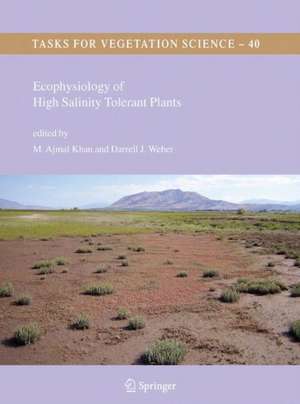Ecophysiology of High Salinity Tolerant Plants: Tasks for Vegetation Science, cartea 40
Editat de M. Ajmal Khan, Darrell J. Weberen Limba Engleză Hardback – 9 dec 2005
| Toate formatele și edițiile | Preț | Express |
|---|---|---|
| Paperback (1) | 1064.12 lei 38-44 zile | |
| SPRINGER NETHERLANDS – 10 oct 2008 | 1064.12 lei 38-44 zile | |
| Hardback (1) | 1097.24 lei 38-44 zile | |
| SPRINGER NETHERLANDS – 9 dec 2005 | 1097.24 lei 38-44 zile |
Din seria Tasks for Vegetation Science
-
 Preț: 34.59 lei
Preț: 34.59 lei - 18%
 Preț: 1219.16 lei
Preț: 1219.16 lei - 20%
 Preț: 554.67 lei
Preț: 554.67 lei -
 Preț: 394.12 lei
Preț: 394.12 lei -
 Preț: 396.02 lei
Preț: 396.02 lei -
 Preț: 402.76 lei
Preț: 402.76 lei - 24%
 Preț: 790.14 lei
Preț: 790.14 lei - 18%
 Preț: 1825.75 lei
Preț: 1825.75 lei - 18%
 Preț: 1218.69 lei
Preț: 1218.69 lei - 24%
 Preț: 784.55 lei
Preț: 784.55 lei - 18%
 Preț: 1233.69 lei
Preț: 1233.69 lei -
 Preț: 73.90 lei
Preț: 73.90 lei - 18%
 Preț: 1222.01 lei
Preț: 1222.01 lei - 18%
 Preț: 952.09 lei
Preț: 952.09 lei - 18%
 Preț: 1225.94 lei
Preț: 1225.94 lei -
 Preț: 388.31 lei
Preț: 388.31 lei -
 Preț: 391.40 lei
Preț: 391.40 lei - 18%
 Preț: 1220.45 lei
Preț: 1220.45 lei - 18%
 Preț: 949.23 lei
Preț: 949.23 lei - 18%
 Preț: 943.73 lei
Preț: 943.73 lei - 18%
 Preț: 1238.11 lei
Preț: 1238.11 lei - 18%
 Preț: 1232.26 lei
Preț: 1232.26 lei - 24%
 Preț: 796.74 lei
Preț: 796.74 lei - 24%
 Preț: 1068.96 lei
Preț: 1068.96 lei -
 Preț: 368.40 lei
Preț: 368.40 lei - 18%
 Preț: 1230.03 lei
Preț: 1230.03 lei - 24%
 Preț: 783.42 lei
Preț: 783.42 lei - 18%
 Preț: 948.16 lei
Preț: 948.16 lei - 18%
 Preț: 948.61 lei
Preț: 948.61 lei - 24%
 Preț: 1053.41 lei
Preț: 1053.41 lei
Preț: 1097.24 lei
Preț vechi: 1443.74 lei
-24% Nou
Puncte Express: 1646
Preț estimativ în valută:
209.96€ • 228.78$ • 176.92£
209.96€ • 228.78$ • 176.92£
Carte tipărită la comandă
Livrare economică 19-25 aprilie
Preluare comenzi: 021 569.72.76
Specificații
ISBN-13: 9781402040177
ISBN-10: 1402040172
Pagini: 424
Ilustrații: XVIII, 404 p.
Dimensiuni: 210 x 297 x 28 mm
Ediția:2006
Editura: SPRINGER NETHERLANDS
Colecția Springer
Seria Tasks for Vegetation Science
Locul publicării:Dordrecht, Netherlands
ISBN-10: 1402040172
Pagini: 424
Ilustrații: XVIII, 404 p.
Dimensiuni: 210 x 297 x 28 mm
Ediția:2006
Editura: SPRINGER NETHERLANDS
Colecția Springer
Seria Tasks for Vegetation Science
Locul publicării:Dordrecht, Netherlands
Public țintă
ResearchCuprins
How Salts Of Sodium, Potassium, And Sulfate Affect The Germination And Early Growth Of Atriplex Acanthocarpa (Chenopodiaceae).- Halophyte Seed Germination.- Salt Tolerance Of Some Potential Forage Grasses From Cholistan Desert Of Pakistan.- Variability Of Fruit And Seed-Oil Characteristics In Tunisian Accessions Of The Halophyte Cakile Maritima (Brassicaceae).- Salt Tolerant Plants From The Great Basin Region Of The United States.- Role Of Calcium In Alleviating Salinity Effects In Coastal Halophytes.- Calorespirometric Metabolism And Growth In Response To Seasonal Changes Of Temperature And Salt.- Evaluation Of Anthocyanin Contents Under Salinity (Nacl) Stress In Bellis Perennis L..- A Comparative Study On Responses Of Growth And Solute Composition In Halophytes Suaeda Salsa And Limonium Bicolor To Salinity.- Alleviation Of Salinity Stress In The Seeds Of Some Brassica Species.- Saline Tolerance Physiology In Grasses.- Localization Of Potential Ion Transport Pathways In The Salt Glands Of The Halophyte Sporobolus Virginicus.- Cellular Responses To Salinity Of Two Coastal Halophytes With Different Whole Plant Tolerance: Kosteletzkya Virginica (L.) Presl. And Sporobolus Virginicus (L.) Kunth.- Eco-Physiological Studies On Indian Desert Plants: Effect Of Salt On Antioxidant Defense Systems In Ziziphus Spp.- Sabkha Edge Vegetation Of Coastal And Inland Sabkhat In Saudi Arabia.- Analysis Of The Soil Sustaining Salt Grass (Distichlis Spicata (L.) Greene) Wild Populations In A Semiarid Coastal Zone Of Mexico.- Comparative Salt Tolerance Of Perennial Grasses.- Commercial Application Of Halophytic Turfs For Golf And Landscape Developments Utilizing Hyper-Saline Irrigation.- Salt Tolerance Of Floriculture Crops.- Utilization Of Salt-Affected Soils By Growing Some Acacia Species.- Soil Remediation Via Salt-Conduction And The Hypotheses Of Halosynthesis And Photoprotection.- Mechanisms Of Cash Crop Halophytes To Maintain Yields And Reclaim Saline Soils In Arid Areas.- Halophyte Uses For The Twenty-First Century.- Halophyte Research And Development: What Needs To Be Done Next ?.
Textul de pe ultima copertă
This volume presents new and additional information about the physiology and ecology of halophytic plant species and saline ecosystems.
The halophytes are highly specialized plants, which have greater tolerance to salt. They can germinate, grow and reproduce successfully in saline areas which would cause the death of regular plants. Most halophytic species are found in salt marsh systems along seashores or around landlocked inland lakes and flat plains with high evaporation. The halophytes play very significant role in the saline areas specially in the coast by overcoming the salinity in different ways, viz. with regulating mechanisms in which excess salts are excreted and with out regulating mechanism, which may include succulents or cumulative types. Besides that they protect coast from erosion and cyclones, provide feeding ground and nursery for fish, shrimps and birds. Halophytes get increasing attention today because of the steady increase of the salinity in irrigation systems in the arid and semi-arid regions where the increasing population reaches the limits of freshwater availability. In many countries, halophytes have been successfully grown on saline wasteland to provide animal fodder and have the potential for rehabilitation and even reclamation of these sites. The value of certain salt-tolerant grass species has been recognized by their incorporation in pasture improvement programs in many salt affected regions throughout the world. There have been recent advances in selecting species with high biomass and protein levels in combination with their ability to survive a wide range of environmental conditions, including salinity.
Our limited understanding of how halophytes work, as this may well be our future as our limit of fresh water is reached. It is important that we preserve these unusual plants and their habitats, not just for their aesthetic beauty, but also as a resource for the development of new salt tolerant and halophyte cropof economic importance. Over the last ten years much new information has become available, which is important for agriculture, forestry and floriculture.
The halophytes are highly specialized plants, which have greater tolerance to salt. They can germinate, grow and reproduce successfully in saline areas which would cause the death of regular plants. Most halophytic species are found in salt marsh systems along seashores or around landlocked inland lakes and flat plains with high evaporation. The halophytes play very significant role in the saline areas specially in the coast by overcoming the salinity in different ways, viz. with regulating mechanisms in which excess salts are excreted and with out regulating mechanism, which may include succulents or cumulative types. Besides that they protect coast from erosion and cyclones, provide feeding ground and nursery for fish, shrimps and birds. Halophytes get increasing attention today because of the steady increase of the salinity in irrigation systems in the arid and semi-arid regions where the increasing population reaches the limits of freshwater availability. In many countries, halophytes have been successfully grown on saline wasteland to provide animal fodder and have the potential for rehabilitation and even reclamation of these sites. The value of certain salt-tolerant grass species has been recognized by their incorporation in pasture improvement programs in many salt affected regions throughout the world. There have been recent advances in selecting species with high biomass and protein levels in combination with their ability to survive a wide range of environmental conditions, including salinity.
Our limited understanding of how halophytes work, as this may well be our future as our limit of fresh water is reached. It is important that we preserve these unusual plants and their habitats, not just for their aesthetic beauty, but also as a resource for the development of new salt tolerant and halophyte cropof economic importance. Over the last ten years much new information has become available, which is important for agriculture, forestry and floriculture.
Caracteristici
Ecophysiology of plants adapted to saline areas Halophytes useful for desalinisation of soil Salt tolerant grasses that survive in desert regions Seed germination strategies of salt tolerant plants Halophytic turfs for golf utilizing saline irrigation up to seawater salinity Halophytes for floriculture












